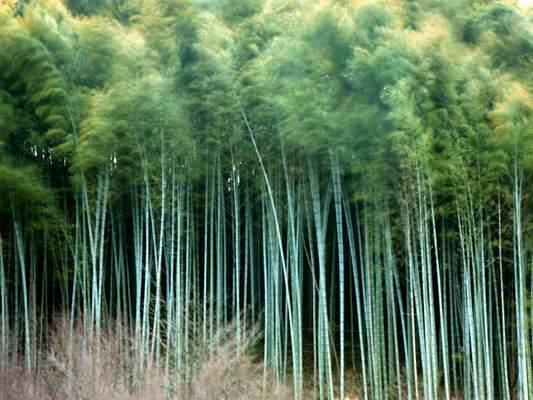Bamboo
The largest of the grasses, there are over 1600 species of bamboo, 64 percent of which are native to Southeast Asia. Thirty-three percent grow in Latin America and the rest in Africa and Oceania. In North America there are only three native species of bamboo as opposed to the 440 species native to Latin America. Bamboo varies in height from dwarf, one foot (30 cm) plants, to giant timber bamboos that can grow to over 100 feet (40 m). Bamboo grows in a lot of different climates, from jungles to high on mountainsides. Bamboos are further classified by the types of roots they have. Some, called runners, spread exuberantly, and others are classified as clumpers, which slowly expands from the original planting. There are also varieties of root systems that are a mixture of these types. Generally, the tropical bamboos tend to be clumpers and the temperate bamboos tend to be runners. Bamboo is both decorative and useful. In many parts of the world it is food, fodder, the primary construction material and is used for making great variety of useful objects from kitchen tools, to paper and dinnerware. They are growing so fast that they are considered to be rapidly renewable resources. Some species under ideal conditions could grow to full height in three to four years for harvesting. Bamboo in North AmericaAll bamboos are naturally evergreen, but only certain species thrive in northern areas. The leaves may not always survive the winter in colder areas, but the rhizome survives and produces new culms (shoots) in the spring from which new leaves emerge. Bamboo is divided into two subgroups based on the rhizomes (the underground stem of the bamboo plant). The pachymorph group is clump forming and usually tropical. The leptomorph group has an open habit and includes the hardy bamboo. A leptomorph stand of bamboo can become a tight, intersecting mass of rhizomes. The culms sprout at random, forming a dense, impenetrable screen. There are three major types of hardy bamboos: Arundinaria, Phyllostachys and Sasa. Arundinaria species are very active in growth and of medium height. The rhizome of this bamboo produces a large number of culms near the base of the plant. Grown without restriction, an Arundinaria plant will form a dense hedge. Phyllostachys forms a less dense screen and is particularly suitable for a grove or a high, open screen. The culms of the Phyllostachys tend to grow upright and straight. The foliage is delicate, light green and is symmetrically placed on the branches. The familiar form that we see in oriental gardens is a grove of isolated culms. Phyllostachys species are especially suitable for these treatments. Sasa species run small, but they can tolerate shade making them well suited for dense screens. Sasa species make striking accent plants, with long, broad leaves overshadowing short stems. Leaves are dark green, sometimes variegated, and have a rough texture and shape. There are several ways to handle the invasive tendency of bamboo. The simplest is to remove shoots as they appear. This can be done while mowing the lawn. Whole rhizome systems can also be pulled from the ground when they appear but this can disrupt surrounding plants. The best way to handle invasive bamboo is to confine it with barriers. Natural barriers include outcroppings of rock or edges of a pond. Galvanized metal or an apron of concrete also make effective barriers. Bamboos grow best in rich soil that is not too dry. They tolerate light shade, though in northern gardens more sun and a warm, sheltered spot are best. Fertilizer should be applied liberally as a top dressing on top of the soil. UsesBamboo is the most used grass in the world and is rapidly renewable. Growth brings healthier air to our environment. Bamboo has been used widely in the world for thousand of years, from basic building material to the new high tech laminated bamboo plywood and flooring with more uses coming in the near future. Some of the bamboo species we work with are Moso bamboo, black bamboo, Iron bamboo, Guadua bamboo and Chinese Bamboo. |


